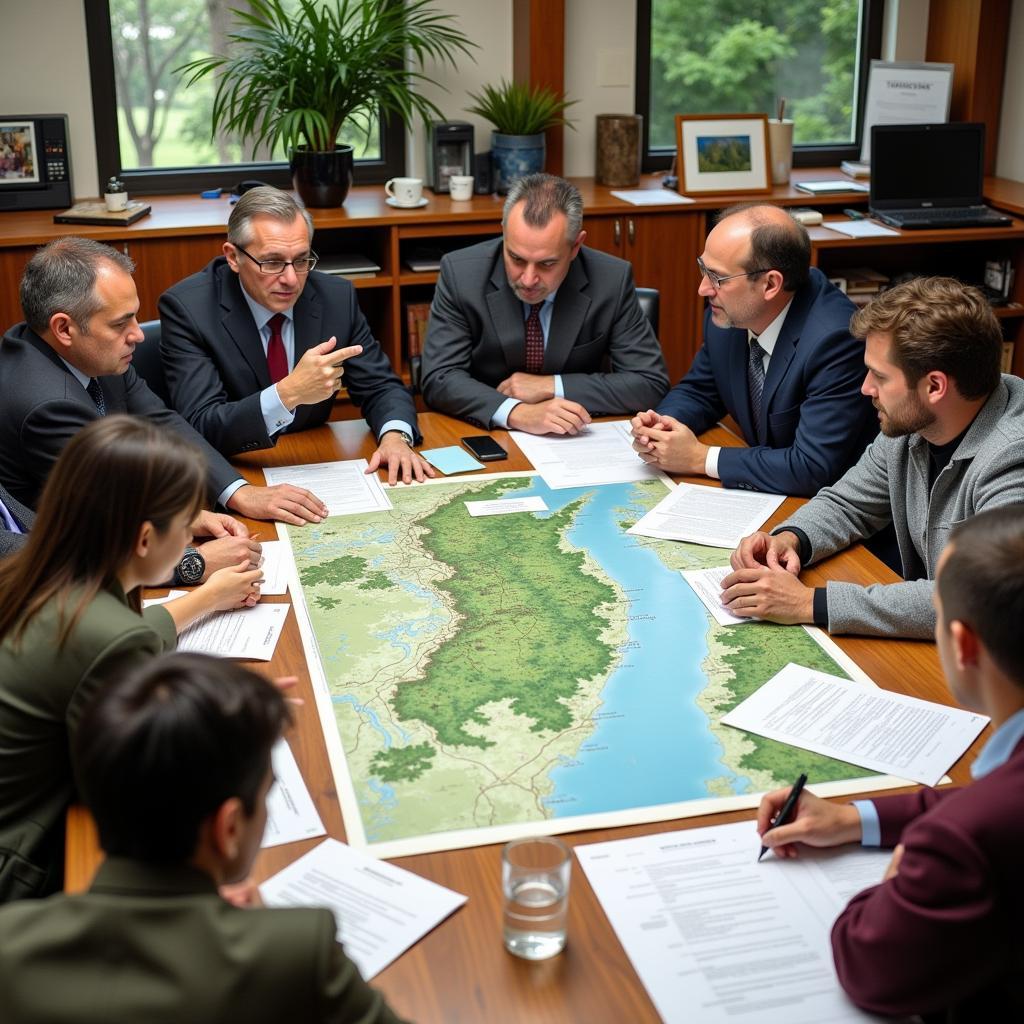The ability to vividly describe a nature reserve or sanctuary is a valuable skill for the IELTS Speaking test. This topic has appeared in past exams and is likely to continue being relevant, given the growing global interest in environmental conservation and eco-tourism. Let’s explore how to effectively tackle this subject across all parts of the IELTS Speaking exam.
Part 1: Introduction and Interview
In this section, the examiner may ask general questions about nature reserves and sanctuaries. Here’s a sample question with a suggested answer:
Examiner: Do you enjoy visiting nature reserves?
Candidate (Band 7-8 response): Absolutely! I find visiting nature reserves to be an incredibly refreshing and enlightening experience. It’s a wonderful opportunity to disconnect from the hustle and bustle of city life and immerse myself in the serenity of nature. I particularly enjoy observing wildlife in their natural habitats and learning about different ecosystems.
 IELTS Speaking: Answering a question about nature reserves
IELTS Speaking: Answering a question about nature reserves
Part 2: Long Turn
Here’s a sample cue card for this topic:
Describe a nature reserve or sanctuary you have visited
You should say:
- Where it was located
- When you visited it
- What you saw there
- And explain how you felt about this visit
Sample answer (Band 6-7):
I’d like to talk about a nature reserve I visited last summer called the Sundarbans Mangrove Forest. It’s located in the delta region of Bangladesh and India.
I went there with my family during our summer vacation. We took a guided boat tour through the winding rivers and channels of the mangrove forest. It was an incredible experience to see such a unique ecosystem up close.
During our visit, we saw a variety of wildlife. The most exciting moment was when we spotted a Bengal tiger in the distance, which is one of the endangered species that the reserve protects. We also saw many birds, like kingfishers and herons, and some crocodiles sunbathing on the riverbanks.
I felt really amazed by the visit. It was eye-opening to see how important these protected areas are for preserving biodiversity. The experience made me more aware of environmental issues and the need to protect natural habitats.
Sample answer (Band 8-9):
I’d like to describe my visit to the Sundarbans Mangrove Forest, a UNESCO World Heritage Site straddling the border of Bangladesh and India. This vast and intricate ecosystem is renowned for its rich biodiversity and serves as a critical habitat for numerous endangered species.
I had the privilege of exploring this ecological treasure last summer during a family vacation. We embarked on a three-day expedition led by knowledgeable local guides, which allowed us to fully immerse ourselves in the unique environment of the world’s largest mangrove forest.
The Sundarbans offered a plethora of awe-inspiring sights. The highlight was undoubtedly catching a glimpse of the elusive Bengal tiger, an experience that left me utterly spellbound. We also observed a diverse array of avian species, including the vibrant plumage of kingfishers and the graceful silhouettes of herons in flight. The sight of massive saltwater crocodiles basking on the mudflats was both thrilling and slightly unnerving.
This visit was truly transformative for me. I was profoundly moved by the delicate balance of nature in this ecosystem and gained a deeper appreciation for the importance of conservation efforts. The experience sparked a newfound passion for environmental protection and left me with a sense of responsibility to contribute to the preservation of such invaluable natural sanctuaries.
Follow-up questions:
- What other wildlife did you see in the reserve?
- How do you think tourism impacts nature reserves like the Sundarbans?
Sample answers (Band 7-8):
-
Apart from the Bengal tiger, we encountered a diverse range of fauna. We spotted several species of primates, including the charismatic rhesus macaques swinging through the trees. The waterways were teeming with life, from playful Ganges river dolphins to various fish species. We also observed some magnificent birds of prey, such as the white-bellied sea eagle, soaring above the canopy.
-
Tourism in nature reserves like the Sundarbans can be a double-edged sword. On one hand, it can raise awareness about conservation and provide crucial funding for protection efforts. However, if not managed sustainably, it risks disturbing wildlife habitats and disrupting delicate ecosystems. I believe the key lies in implementing strictly regulated ecotourism practices that prioritize the preservation of the environment while still allowing visitors to appreciate these natural wonders.
Part 3: Two-way Discussion
Examiner: How can governments better protect nature reserves and wildlife sanctuaries?
Candidate (Band 6-7 response):
Governments can protect nature reserves and wildlife sanctuaries in several ways. They can increase funding for conservation efforts and hire more rangers to patrol these areas. Stricter laws against poaching and illegal logging would also help. Education programs can teach people about the importance of these places. Lastly, working with local communities to find sustainable ways to use the land could reduce conflicts between humans and wildlife.
Candidate (Band 8-9 response):
Governments can adopt a multi-faceted approach to enhance the protection of nature reserves and wildlife sanctuaries. Firstly, they should allocate substantial resources towards conservation efforts, including funding for research, habitat restoration, and the employment of well-trained rangers.
Implementing and enforcing robust legislation against activities such as poaching, illegal logging, and habitat destruction is crucial. This should be complemented by severe penalties for offenders to serve as a deterrent.
Moreover, governments should focus on fostering public awareness through comprehensive education programs. These initiatives can cultivate a sense of stewardship among citizens, encouraging them to actively participate in conservation efforts.
Collaboration with local communities is paramount. By developing sustainable livelihood options that align with conservation goals, governments can mitigate human-wildlife conflicts and ensure the long-term viability of protected areas.
Lastly, international cooperation is essential, especially for reserves that span multiple countries. Governments should engage in cross-border conservation agreements and share best practices to create a unified approach to environmental protection.
 Government officials discussing nature reserve protection
Government officials discussing nature reserve protection
Examiner: What role do you think technology can play in conservation efforts?
Candidate (Band 8-9 response):
Technology has the potential to revolutionize conservation efforts in numerous ways. Advanced monitoring systems, such as drone technology and satellite imaging, can provide real-time data on wildlife populations and habitat changes, enabling conservationists to respond promptly to threats.
Artificial intelligence and machine learning algorithms can process vast amounts of data to identify patterns and predict potential issues, such as disease outbreaks or poaching hotspots. This proactive approach allows for more efficient resource allocation and targeted interventions.
DNA sequencing and genetic analysis technologies are invaluable for studying biodiversity and tracking endangered species. These tools can help in developing more effective breeding programs and understanding the genetic health of populations.
Furthermore, innovative tracking devices and GPS collars allow researchers to gather crucial information about animal behavior and migration patterns, informing conservation strategies and habitat protection efforts.
Lastly, technology can play a significant role in public engagement and education. Virtual reality experiences and interactive online platforms can bring nature reserves to life for people who may never have the opportunity to visit in person, fostering a global community of conservation advocates.
Key Vocabulary and Phrases for High Scores
-
Biodiversity /ˌbaɪəʊdaɪˈvɜːsəti/ (noun): The variety of plant and animal life in a particular habitat.
Example: The Amazon rainforest is known for its incredible biodiversity. -
Ecosystem /ˈiːkəʊˌsɪstəm/ (noun): A biological community of interacting organisms and their physical environment.
Example: Mangrove forests form a unique ecosystem that supports both aquatic and terrestrial life. -
Conservation /ˌkɒnsəˈveɪʃn/ (noun): The protection of plants, animals, and natural areas.
Example: The wildlife sanctuary is dedicated to the conservation of endangered species. -
Habitat /ˈhæbɪtæt/ (noun): The natural home or environment of an animal, plant, or other organism.
Example: Deforestation is rapidly destroying the natural habitat of many species. -
Sustainable /səˈsteɪnəbl/ (adjective): Able to be maintained at a certain rate or level without depleting natural resources.
Example: The nature reserve promotes sustainable tourism to minimize environmental impact. -
Endemic /enˈdemɪk/ (adjective): Native and restricted to a certain place.
Example: The Galápagos Islands are home to many endemic species found nowhere else on Earth.
Tips from an IELTS Speaking Examiner
-
Practice describing natural environments in detail. Focus on using vivid adjectives and specific terminology related to ecosystems and wildlife.
-
Develop your vocabulary related to nature and conservation. Familiarize yourself with terms like “biodiversity,” “ecosystem,” and “endangered species.”
-
Prepare personal anecdotes about visits to nature reserves or wildlife sanctuaries. These can be valuable for answering questions in Part 2 and Part 3 of the test.
-
Stay informed about current environmental issues. This knowledge can be useful for discussing the importance of nature reserves and conservation efforts.
-
Use a variety of grammatical structures to showcase your language skills. Include conditional sentences, passive voice, and complex sentence structures where appropriate.
-
Practice expressing opinions on environmental topics. Be prepared to discuss both the positive and negative aspects of issues related to nature reserves and conservation.
By following these tips and incorporating the suggested vocabulary and phrases, you’ll be well-prepared to discuss nature reserves and sanctuaries in your IELTS Speaking test. Remember, the key is to speak fluently, use a range of vocabulary, and express your ideas clearly and coherently.
For more practice on describing natural environments, you might find it helpful to describe a nature spot you often visit. Additionally, to expand your vocabulary and ideas related to less-visited areas, consider practicing how to describe a place in your country that tourists rarely visit. These exercises will further enhance your ability to discuss various aspects of natural and less-explored locations, which can be valuable for the IELTS Speaking test.


